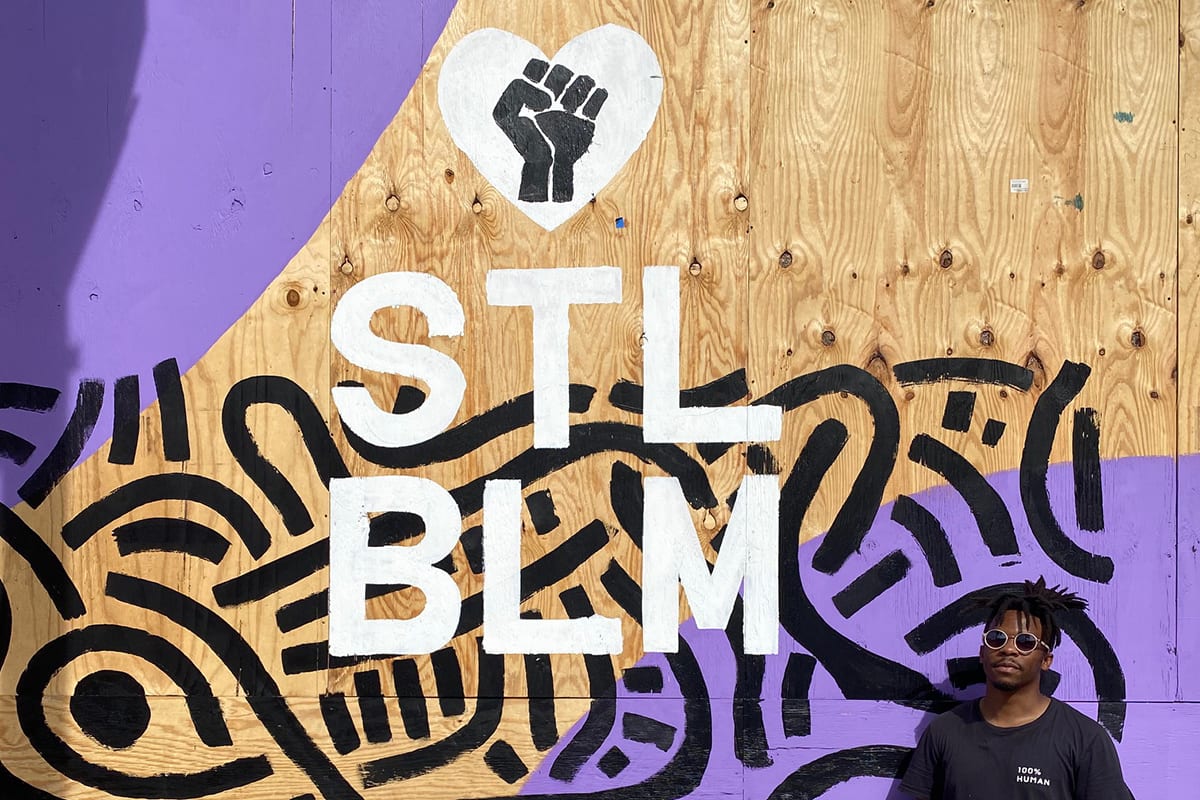After a peaceful protest over the death of George Floyd, the Minneapolis man who died in police custody, ended in chaos, several St. Louis businesses boarded up their storefronts. Instead of seeing damaged buildings, Jayvn Solomon, ’14, and Tyson Baker, ’17, graduates of Maryville’s design and visual arts programs, saw blank canvases.
The two came up with the idea of having Black artists paint the boarded-up storefronts, and paying them for their work. They co-founded PaintedBlack STL to empower Black artists to share their messages on these damaged buildings.
Since its founding earlier this month, PaintedBlack STL has completed seven projects across the St. Louis area and raised nearly $13,000 through its GoFundMe campaign. Funds are being used to pay for materials and supplies for projects, and the remaining balance will be split evenly among the participating artists.
The first project was completed by Solomon on the exterior of Bella’s Frozen Yogurt. He created a mural of black dots and lines over purple semi-circles. The center features a Black fist inside a white heart with the letters “STL BLM” — St. Louis Black Lives Matter. “I wanted the design to be simple and I wanted to show what I believe in,” Solomon said. “I believe in St. Louis. I’m also Black, and I believe my life matters.”
Other projects include George Floyd’s face in shades of gray with the words “One man can change the world” outside the Big Shark Bicycle Company. Colorful vines on a Medicine Shoppe Pharmacy include the names of people who have died at the hands of police.
The community response to PaintedBlack STL has been overwhelming. “We’ve had a huge outpouring of support from so many individuals that have offered to help,” Baker said. “We even have people who have found creative ways to start their own fundraising initiatives, from selling hot sauce to commissioned pet portraits. It’s been really incredible.”
But for some St. Louisans, the artwork has been polarizing. “Some perceive that these buildings were damaged by the Black Lives Matter movement, but we know that isn’t true,” Baker said. “That’s the point we’re trying to make here. Why not put a message of solidarity on a building that was damaged? Why aren’t we supporting Black artists and inviting them to share their messages? It’s our hope that these works of art becomes symbols of community pride, hope, cooperation and equity.”
PaintedBlack STL is in talks with dozens of artists and businesses about additional projects, and are still seeking collaborations throughout the St. Louis area. The group is also looking to the future and how it can continue to support Black artists, even after the boards come down. “We are asking our artists how we can help support them,” Solomon said. “We are working with the creative Black community, not for the creative Black community. We want our artists to have genuine ownership.”
That philosophy stems from Solomon’s and Baker’s personal experiences. Oftentimes, artists are underpaid or undervalued. The two learned the importance of supporting artists through their time at Maryville. Though they weren’t on campus at the same time, they met through a networking opportunity facilitated by Maryville faculty. They bonded over the ways their supportive professors and small class sizes changed their lives and prepared them for careers in hospitality design.
Solomon is also deeply connected in the St. Louis art community and the mastermind behind #Loutopia, where he explores the potential of abandoned buildings and how art can revitalize St. Louis. He incorporates graphic design, illustration and animation, skills he honed through his Maryville coursework. His #Loutopia experiences influenced the founding of PaintedBlack STL, and both projects envision a better future for St. Louis.
“I think we’re growing right now, and sometimes growing has a little pain in it,” Solomon said. “Like a lot of folks, I’m still learning about race in America. But I think the only real solution is a just system, which means fixing or replacing some of the systems we currently have in place. We need to learn to cut through all the malice and ill intent and learn to talk to one another.”
